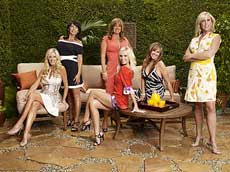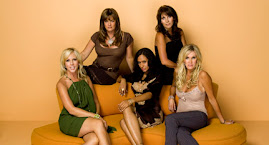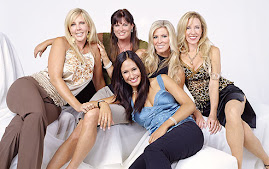


From Reference for Business.com -
(The last pic is Tammy and her daughter looking a the home they lost after the company BK)
Origins
The roots of Charisma Brands date to 1985, when husband-and-wife entrepreneurs Louis and Tammy Knickerbocker founded a California-based firm called International Beauty Supply. The couple, who had earlier found success with Mexican restaurant chain Casa Lupita, soon began to market a home nail salon kit via cable televisions's Home Shopping Network.
After Louis Knickerbocker met plastic surgeon Michael Elam at a party, the company formed an offshoot called LaVie Cosmetics to make a face cream that the two men developed. Recruiting comedian and Elam patient Phyllis Diller as on-air spokesperson, the firm soon began to sell Creme de LaVie on the Home Shopping Network, taking orders for $997,000 worth in a single August 1988 weekend.
In 1989, another offshoot company, MLF Enterprises, was created. It would offer replicas of jewelry pieces owned by Charlie's Angels star Farrah Fawcett, who would also hawk the line on the Home Shopping Network. Not long afterward an additional division, Knickerbocker Creations, was launched as well. By 1990, the company was reportedly handling orders worth $18 million from the Home Shopping Network, which was nearly its exclusive source of revenue.
In 1990, he later alleged, Louis Knickerbocker was approached by Home Shopping Network chairman Roy Speer with a proposal that he secretly receive a 50 percent stake in Knickerbocker's businesses in exchange for arranging a $10 million line of credit. After checking with his lawyer about the propriety of such an offer, Knickerbocker declined it, which resulted in Speer banning the company's products from his network and then trying to woo away its celebrity spokespersons.
The firm soon reached a deal with rival shopping channel QVC, but Speer allegedly continued to keep track of its inner workings by paying Knickerbocker's executive vice-president to spy for him. The allegations surfaced several years later when government agencies began a probe of the Home Shopping Network's finances, which precipitated Speer's resignation as that firm's chairman and the sale of his controlling interest. Meanwhile, 1990 had also seen Knickerbocker drop Crème de LaVie face cream after co-inventor Michael Elam's medical license was revoked for malpractice and insurance fraud.
Marie Osmond Dolls Debut in 1991
In 1991, the company moved into a new product area with the introduction of Marie Osmond Fine Porcelain Collector Dolls. Doll aficionado Osmond helped design the new line, which would be sold via QVC and in stores like Toys "R" Us and JC Penney. Prices started at $25 and went as high as $6,000 for a limited-production special edition, with most selling for around $200. The first dolls debuted on QVC in November of 1991, with the company reporting sales of $1.4 million in four hours of air time. Osmond donated a portion of her proceeds to the Children's Miracle Network, a charity she helped establish in 1983.
The success of the Osmond dolls led to a similar deal the following year with former Mouseketeer and 1960s beach movie star Annette Funicello, who would sell a line of collectible bears under her name. Funicello suffered from multiple sclerosis, and part of the proceeds would fund a charity she had formed to help fight neurological diseases. Despite initial success with dolls and bears, by 1994 the company's annual sales had fallen to $7.8 million, with net earnings of $725,000.
In January 1995, Louis Knickerbocker's various businesses were merged into a single entity, the Rancho Santa Margarita, California-based L.L. Knickerbocker Company. That same month, the firm raised $4.9 million in an initial public offering (IPO) of stock on the NASDAQ Small Cap exchange. Of the 2.4 million shares extant, Louis Knickerbocker held 64 percent. The company used the funds to develop new products and to create television infomercials and a direct marketing sales campaign. At this time, the Marie Osmond doll line was the firm's biggest seller, accounting for approximately 40 percent of sales, with most of the remainder coming from Annette Funicello Collectible Bears and the ECT Ionizer, a product which purportedly removed harmful particles from indoor environments.
Following the IPO, L.L. Knickerbocker began signing a number of new licensing deals. Plans were soon announced to offer memorabilia and figurines based on the 1950s television program The Honeymooners, hair removal and skin care products, a recovery service for lost or stolen articles called Tracker, and a line of collectible angel dolls promoted by flamboyant fitness guru Richard Simmons. The firm also took a dip in the waters of the Internet, creating a joint venture with MultiMedia Magic Productions to develop "Electronic Storefronts" for online sales of a variety of products.
All of this activity, as well as new business from mail-order sales via advertisements in Doll Reader magazine, helped boost the company's stock value tenfold by mid-summer 1995, and in July the NASDAQ exchange moved it to the higher-profile National Market System. Over the summer, more new products were announced, including a series of videos called "Secrets of Modeling A-Z," which would be sold via infomercials.
With more attention directed toward the firm's once thinly traded stock, allegations began to surface that stockbroker Rafi Khan was somehow manipulating its price, and with reports of a possible Securities and Exchange Commission (SEC) investigation, it began falling. By late August, it had dropped to less than half of its recent peak, and then continued to slide.
In the fall of 1995, L.L. Knickerbocker began marketing its modeling videos via infomercials and selling the Tracker recovery service on QVC with help from actress Angie Dickinson, formerly the star of television's Police Woman series. The company also announced it would market a digital telephone with which users could make free long distance calls via the World Wide Web as well as a series of posters of company board member Farrah Fawcett, who had recently posed nude for Playboy magazine at the age of 48. Late in the year, L.L. Knickerbocker sold $3 million worth of new Christmas-themed Marie Osmond dolls in a single weekend on QVC, as the company announced plans to begin selling them through retail outlets like FAO Schwarz. QVC sales accounted for some 98 percent of revenues for the firm at this time.
In December 1995, a $10 million joint venture was formed with Paxson Communications to market products via informercials and through Paxson's new Shop at Home cable TV network. The first efforts included selling exercise devices endorsed by Olympian Florence Griffith Joyner and marketing Mr. Khalsa Numerology to compete with the successful Psychic Friends Network. For 1995, the firm reported sales of $13.1 million and earnings of $1.3 million.
Acquisitions and New Ventures in 1996
In March 1996, L.L. Knickerbocker entered a completely new business area by purchasing a 40 percent stake in Pure Energy Corp., a California firm that sought to produce an alternative motor fuel from industrial waste products. Pure Energy, which would be headed by Louis Knickerbocker, soon committed to invest $5.3 million in a wood-sludge conversion plant in Watertown, New York, which would also be funded by state and federal agencies and a chemical firm.
In the spring, the company expanded its offerings to jewelry through the acquisition of three companies: The Krasner Group, Inc. of Rhode Island, which sold jewelry designed by the likes of Kenneth Jay Lane and Nolan Miller on QVC, and Grant King International Co. Ltd. and S.L.S. Trading Co. Ltd., both of Thailand. The three new additions had total annual revenues of approximately $20 million.
Key Dates:
1985: Louis and Tammy Knickerbocker found International Beauty Supply.
1991: The company begins to sell Marie Osmond Fine Porcelain Dolls via the QVC television shopping network.
1995: The firm, now known as L.L. Knickerbocker, goes public on NASDAQ.
1996: Jewelry companies are acquired.
1999: The firm is forced into bankruptcy by creditors.
2001: Brian Blosil acquires the assets of Knickerbocker; the firm becomes Marian LLC.
2004: Blosil sells the company to management; Marian's name is changed to Charisma Brands LLC.
In the summer of 1996, the firm bought a 25 percent stake in Insta-Heat Inc. and sister firm Self-Heating Container Corp. (later known as Ontro, Inc.), which had developed cans that could be heated by pressing a button on the bottom. Fall saw the addition of another Thai jewelry company, Harlyn International Co., and the signing of an agreement with country music superstar Barbara Mandrell to tout a line of jewelry on QVC.L.L. Knickerbocker also bought controlling interest in New England-based doll maker Georgetown Collection, Inc. and subsidiary Magic Attic Press for $1.68 million. The respective firms produced collectible porcelain dolls and 18-inch vinyl dolls for children that were modeled after the successful American Girls line and sold with related storybooks and accessories.
In the summer of 1997, the company formed a joint venture with Arkenol Holdings to market alternative fuels in Asia, securing a new $20 million line of credit. Several of the company's recent ventures were now beginning to run into problems, with the Tracker service's telemarketers accused by the Federal Trade Commission of using scare tactics to sell unnecessary credit card insurance and Classy Lady hair removal devices abandoned when they did not receive Food and Drug Administration approval. The firm reported a loss of $4.4 million on sales of $68.3 million for the year.
The year 1998 saw L.L. Knickerbocker working to cut costs by consolidating its Far East offices into a single site in ShenZhen, China, and farming out Magic Attic Press book production and marketing to Millbrook Press. The company also secured $7 million in new financing from private investors, built a new silver manufacturing facility in Thailand, and took a6.7 percent stake in Phoenix Environmental Ltd. in exchange for 2 percent of its Pure Energy holdings. The company continued to sign new licensing agreements as well, with recent additions including Disney, Universal Studios, and Kodak.
In July 1998, the SEC officially charged Rafi Khan and a partner of manipulating L.L. Knickerbocker stock five years earlier, though the company itself was not implicated. Khan agreed to cooperate with prosecutors and received a sentence of three years' probation and a five-year ban from the securities industry.
With losses continuing to mount, the company's stock price began falling steadily, ameliorated only slightly by announcements of new Internet sales efforts through Yahoo! and America Online. To help boost share value, the firm split off its holdings in the energy and self-heating container businesses by forming a new company called Knickerbocker Investments, Inc., which would be run by an independent advisory board. A short time later, another new unit, Knickerbocker WorldWide Co. was created to sell jewelry online. The company also relocated its Georgetown Collection business from Maine to California, consolidated related operations in Portland, Maine, and closed manufacturing facilities in Maine, New York, and Pennsylvania. One-quarter of the firm's 290 U.S. employees were laid off as a result of the downsizing, leaving a total of 450 worldwide. For 1998, L.L. Knickerbocker's revenues declined to $60 million and a whopping $28 million loss was reported.
Bankruptcy in 1999
With its Asian joint venture with Arkenol also recently declared a total loss, and having spent over $1 million on legal fees related to two separate lawsuits, by the summer of 1999 the company found itself in serious trouble. On August 23, as the firm's stock was coincidentally being delisted from the NASDAQ due to its low trading price, three of L.L. Knickerbocker's creditors filed a Chapter 7 petition in U.S. Bankruptcy Court seeking immediate payment of their debts. The firm began seeking a way out of liquidation, and in November it was allowed to convert from a Chapter 7 forced bankruptcy to a Chapter 11 reorganization and began negotiations with creditors. For the year, the company recorded revenues of $42.2 million and a loss of $11.2 million.
During the fall of 1999 and into early 2000, operations were streamlined by selling the unprofitable Georgetown Collection brand and discontinuing the Annette Funicello and Richard Simmons product lines. The firm also began to move away from the money-losing mail order area and toward retail sales, though QVC continued to account for nearly half of its earnings. For 2000, sales declined to $30.3 million, with a net loss of $3.4 million. The company's employee ranks had by now been whittled down to 357.
In July 2001, L.L. Knickerbocker accepted an offer of $6 million from Brian Blosil, the husband of Marie Osmond, to buy substantially all of its assets, which would form the basis of a newly formed company called Marian, LLC. Louis Knickerbocker subsequently filed a plan of liquidation with the bankruptcy court for the minimal remaining assets he held. The firm's founder later reappeared with a company called RG Global Lifestyles, Inc., that marketed dietary supplements and health and beauty aid products in Asia, as well as a device that created drinking water from air.










No comments:
Post a Comment